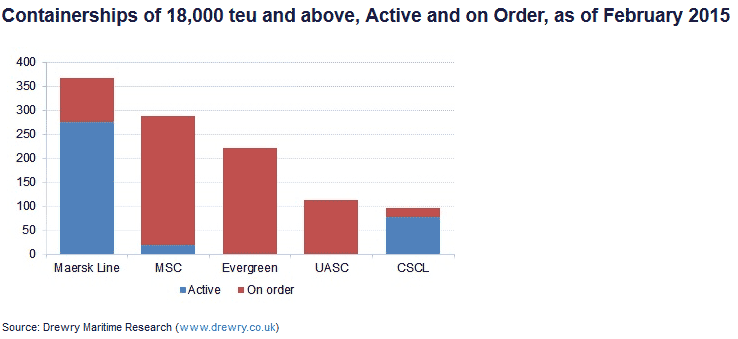From SCDigest's On-Target e-Magazine
- March 4, 2015 -
Global Supply Chain News: Big Ship Orders Keep Coming, but 25,000 TEU Ships Possible but Unlikely
Big Ship Orders Changing the Industry, Drewry Says, While Maersk CEO Says 18,000 TEU is the Sweetspot
SCDigest Editorial Staff
Ocean container carrier Evergreen recently announced it was the latest company to order a ship capable of carrying more than 18,000 TEU, signing a charter agreements with Shoei Kisen Kaisha, Ltd. for 11 Ultra Large Container Vessels (ULCVs).
The analysts at Drewry Shipping say that with this order, the total sum for ships of 18,000 TEU and above, either active or on order, has now passed the 1 million TEU mark, as shown in the graphic below.
SCDigest Says: |
 |
Since 2007, the average ship size on Asia to Europe routes has doubled to 13,000-14,000 TEU but port productivity has only increased 50%, meaning ships spend on average 18 days in port rather than 12. |
|
What Do You Say?
|
|
|
|
Maersk is of course us leading the way, with more than 250,000 TEU of active capacity with it Triple E ships, and another 100,000 still on the order book. MSC has also really taken the latest megaship plunge, with apparently one such ship on order and another 300,000 TEU of capacity still to come.
Ironically, one of the attractions of the latest generation of these 18,000-TEU ships is that they are better at slow steaming! Evergreen says ship's new generation G-type main engine on the ships it ordered have a longer stroke in order to sail more efficiently at lower speeds, helping to reduce fuel consumption and greenhouse gas emissions by an estimated 7 % compared with traditional main engines.
It's ironic because slow steaming effectively reduces capacity at the same time the carriers are adding capacity with these new giant ships.
It was only 7-8 years ago that the industry first started talking about "megaships" capable of carrying more than 10,000 TEU.
Drewry has previously described the latest rush for ULVCs as an "arms race," and said the new capacity is putting a lot pressure on the industry and individual carriers.
"A more apt description is probably "Follow the leader," Drewry says. "If we take a step back into the recent past, the history of orders for the latest biggest ships reveals a common trend - Maersk Line makes the first order and other carriers eventually follow. The main change is that carriers are taking less time to play catch-up," in a trend that dates back to the mid-1990s.

But these giant ships are also having a significant impact on the industry. As the ships get larger and larger, fewer and few carriers have the volumes to fill up the ships with weekly service. While the various alliances have been created/expanded in part to address that issue by combining volumes across a group of carriers, Drewry says.
"What this means is that the container industry will effectively become a two-tier arena with the haves enjoying far greater economies of scale over the have-nots," though the have-nots having some access to the giant ships through the alliances.
In fact, Drewry expects future ULCV orders to be placed according to alliance needs rather than meeting individual lines' requirements. "There is simply not enough cargo for everyone to have ULCVs," Drewry says.
(Global Supply Chain Article Continued Below)
|